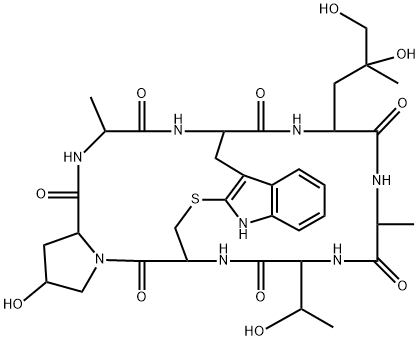17466-45-4

Product Name:
PHALLOIDIN
Formula:
C35H48N8O11S
Synonyms:
;Phalloidin, Amanita phalloides - CAS 17466-45-4 - Calbiochem
Inquiry
CHEMICAL AND PHYSICAL PROPERTIES
| Physical Description | White solid; [MSDSonline] |
|---|---|
| Melting Point | MAXIMUM ABSORPTION (WATER): 295 NM (E= 0.597, 1%, 1 CM); MELTING POINT: 280-282 °C /HEXAHYDRATE/ |
| Solubility | SOLUBILITY IN WATER: O.5% AT 0 °C; MUCH MORE SOLUBLE IN HOT WATER; FREELY SOLUBLE IN METHANOL, ETHANOL, BUTANOL, PYRIDINE /HEXAHYDRATE/ |
| Other Experimental Properties | NEEDLES FROM WATER /HEXAHYDRATE/ |
| Chemical Classes | Biological Agents -> Mushroom Toxins |
SAFETY INFORMATION
| Signal word | Danger |
|---|---|
| Pictogram(s) |
 Skull and Crossbones Acute Toxicity GHS06 |
| Precautionary Statement Codes |
P260:Do not breathe dust/fume/gas/mist/vapours/spray. P262:Do not get in eyes, on skin, or on clothing. P264:Wash hands thoroughly after handling. P264:Wash skin thouroughly after handling. P280:Wear protective gloves/protective clothing/eye protection/face protection. |
COMPUTED DESCRIPTORS
| Molecular Weight | 788.9 g/mol |
|---|---|
| XLogP3 | -1.7 |
| Hydrogen Bond Donor Count | 11 |
| Hydrogen Bond Acceptor Count | 12 |
| Rotatable Bond Count | 4 |
| Exact Mass | 788.31632555 g/mol |
| Monoisotopic Mass | 788.31632555 g/mol |
| Topological Polar Surface Area | 317 Ų |
| Heavy Atom Count | 55 |
| Formal Charge | 0 |
| Complexity | 1510 |
| Isotope Atom Count | 0 |
| Defined Atom Stereocenter Count | 0 |
| Undefined Atom Stereocenter Count | 10 |
| Defined Bond Stereocenter Count | 0 |
| Undefined Bond Stereocenter Count | 0 |
| Covalently-Bonded Unit Count | 1 |
| Compound Is Canonicalized | Yes |
PRODUCT INTRODUCTION
description
Phalloidin is one of a group of toxins from the death cap (Amanita phalloides) known as phallotoxins. The phallotoxins consist of at least seven compounds, all of which have seven similar peptide rings, isolated from the death cap (Amanita phalloides). Though highly toxic to liver cells, it has since been found to have little input into the death cap's toxicity as it is not absorbed through the gut. Furthermore, it is also found in the edible (and sought after) Blusher (Amanita rubescens). (L996)